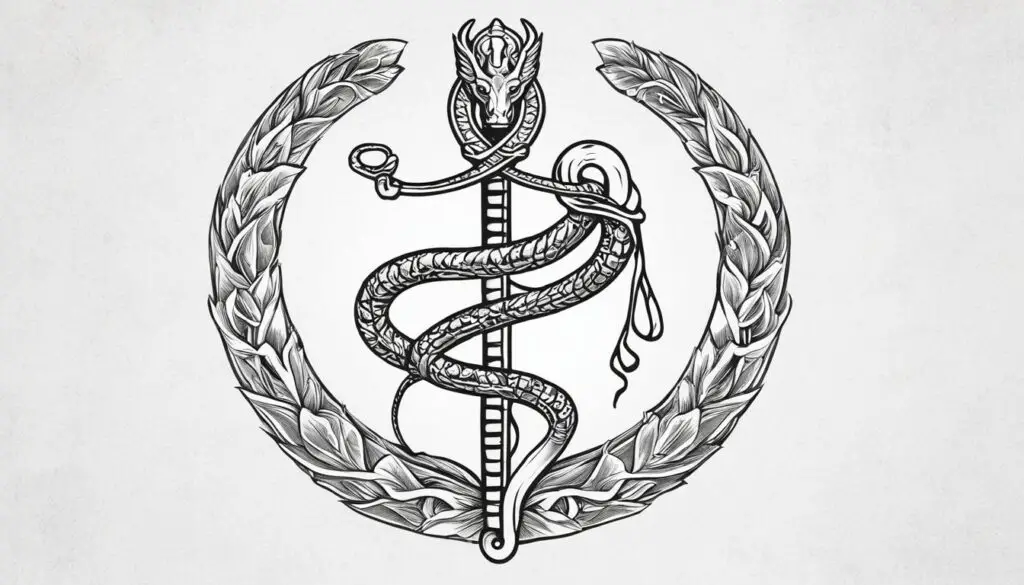Welcome to the fascinating world of Greek mythology! In this article, we will delve into the deep symbolism and meaning behind snakes in ancient Greek culture. Snakes played a significant role in Greek mythological tales, representing both divine beings and powerful symbols. Let’s explore the various interpretations and understand why snakes were revered and feared by the ancient Greeks.
Snakes in Greek mythology were more than just creatures; they embodied a duality of meanings. On one hand, they were seen as guardians of sacred spaces, protecting the divine and maintaining order. On the other hand, they were associated with divine punishment, representing the consequences of human hubris and disobedience in Greek myths. Their symbolism runs deep, and by studying their role in Greek mythology, we gain insights into the cultural interpretations of these captivating creatures.
Throughout this article, we will uncover the hidden meanings behind various mythological snakes, such as Medusa’s snake hair and the serpent-slaying Python. We will also explore the connection between snakes and healing in the context of Asclepius, the Greek god of healing and medicine. Additionally, we will discuss the symbolism behind the Caduceus, the famous snake-entwined staff associated with Hermes.
Not only did snakes hold significance in the mythological realm, but they also represented concepts of transformation, fertility, and the cyclical nature of the Earth. We will examine how snakes shed their skin, symbolizing rebirth and immortality, and their association with fertility rituals and Earth’s cycles.
Join us on this mythological journey as we unravel the enduring influence of snake symbolism and its relevance in modern cultural contexts. From Greek mythology to our world today, snakes continue to fascinate and captivate our imagination.
Key Takeaways:
- Snakes in Greek mythology hold deep symbolism and meanings, representing a duality of qualities.
- They serve as guardians of sacred spaces and are associated with divine punishment.
- Mythical serpents such as Medusa, Python, and the Hydra offer insights into ancient beliefs and fears.
- The connection between snakes and healing is embodied in Asclepius and the symbol of the Rod of Asclepius.
- The Caduceus, entwined by two serpents, symbolizes commerce and carries enduring significance.
Introduction to Snakes as Mythological Symbols
In ancient cultures, mythological symbols played a significant role in conveying profound messages, beliefs, and ideas. Among these symbols, snakes emerged as enigmatic and powerful entities, carrying deep significance across various mythologies. Their association with divine beings and their complex nature made them a focal point of mythological tales.
Snakes have been linked with a multitude of connotations, including wisdom, transformation, fertility, and the cycle of life and death. In Greek mythology, they hold a particularly prominent place, embodying both positive and negative traits.
The image above depicts the mystical allure of snakes as mythological symbols. As we explore their significance in Greek mythology, we gain a deeper understanding of the intricate relationship between these ancient cultures and the natural world.
By examining the broader concept of mythological symbols, we can uncover the profound impact snakes had on ancient cultures. Let us now delve into the captivating world of snake symbolism in Greek mythology, unraveling the layers of meaning they hold and the stories they tell.
What Do Snakes Represent in Greek Mythology

In Greek mythology, snakes hold a deep and multifaceted symbolism. They embody a duality of meanings, representing both positive and negative qualities. Snakes are often associated with wisdom, transformation, and renewal, as well as fertility and the cyclical nature of the Earth.
As guardians of sacred spaces, snakes play a significant role in protecting the divine and maintaining order. They are seen as powerful beings that watch over sacred temples, ancient sanctuaries, and mystical realms.
However, snakes in Greek mythology also symbolize divine punishment. They represent the consequences of human hubris and disobedience, acting as agents of retribution from the gods. Snakes serve as a reminder of the repercussions that come with challenging the divine order.
Explore the rich cultural interpretations and meanings associated with snakes in Greek mythology through fascinating stories and legends.
The Duality of Snake Symbolism
Snakes in Greek mythology embody a duality of meanings, representing both positive and negative qualities. They are often associated with:
- Wisdom and knowledge
- Transformation and renewal
- Protection and guardianship
- Divine punishment and retribution
Snakes as Guardians of Sacred Spaces
The ancient Greeks believed that snakes played a crucial role as guardians of sacred spaces. These divine creatures were seen as protectors of temples, shrines, and other sacred sites. The presence of snakes in these spaces was revered and considered a sign of divine blessing and protection.
Snakes and Divine Punishment
In Greek mythology, snakes are often associated with divine punishment. They serve as instruments of retribution, representing the consequences of human arrogance and disobedience. Snakes are portrayed as agents of the gods, delivering divine justice to those who defy and challenge the natural order.
Mythical Serpents: From Python to Ophiotaurus
Mythical serpents hold a prominent place in Greek mythology, captivating the imagination with their powerful symbolism and intriguing legends. Among these mythical creatures, two fascinating serpents stand out: Python and Ophiotaurus.
Python:
In Greek mythology, Python was a fearsome serpent slain by the god Apollo. Python’s origins trace back to the primordial chaos, making it a symbol of primeval forces and untamed nature. The epic battle between Apollo and Python represents the triumph of light and order over darkness and chaos. Python’s defeat marked the establishment of Apollo’s supremacy as the god of prophecy, music, and knowledge.
Ophiotaurus:

The Ophiotaurus is a creature with a unique combination of characteristics: part serpent and part bull. In Greek mythology, it was believed that slaying an Ophiotaurus could grant immense power, including the ability to control the elements. Due to its significance, the Ophiotaurus was often sought after by gods and mortals alike, leading to epic quests and heroic endeavors.
These mythical serpents offer a glimpse into the ancient beliefs and fears associated with these creatures. The legends surrounding Python and Ophiotaurus reveal the enduring fascination and symbolism that snakes held in Greek mythology.
Asclepius: The Healing Power of the Serpent

In Greek mythology, Asclepius is revered as the ancient god of healing and medicine. What sets Asclepius apart is his close association with snakes, which play a significant role in his mythological stories and symbolism.
Asclepius: A Deity’s Close Connection with Snakes
Asclepius’s deep connection with snakes is evident in the various accounts and legends surrounding his divine healing abilities. According to the myths, Asclepius was raised by the centaur Chiron, who taught him the art of medicine. One day, Asclepius witnessed a serpent bringing healing herbs to another serpent, which then slithered across the injured serpent’s body. Inspired by this act, Asclepius learned the secrets of healing from the snakes themselves.
The presence of snakes in Asclepius’s temples and healing sanctuaries further highlights their importance in his worship. It was believed that non-poisonous snakes inhabited these sacred spaces, serving as messengers between Asclepius and those seeking healing. These serpents were seen as divine beings, embodying the god’s healing power.
The Rod of Asclepius and Its Continuing Significance
The symbol most commonly associated with Asclepius is the Rod of Asclepius, a staff entwined by a serpent. It has become internationally recognized as a representation of healing and healthcare. The snake on the rod is often seen as a metaphor for rejuvenation and shedding of old ailments.
The Rod of Asclepius continues to hold significance in modern-day medical emblems and organizations. It is widely used as a symbol of pharmacies, medical associations, and healthcare facilities, emphasizing the connection between medicine and the ancient healing traditions linked to Asclepius.
Explore the enduring significance of Asclepius and the profound symbolism of snakes in the context of healing. From ancient myths to present-day medical symbolism, the healing power of the serpent remains a testament to the lasting influence of Asclepius in the realm of health and wellness.
Medusa and the Gorgons: Snakes as Instruments of Fear

Medusa, one of the most iconic figures in Greek mythology, is known for her snake-like hair and petrifying gaze. With her serpentine attributes, Medusa instilled fear in those who encountered her, turning them to stone with a single glance. The symbolism behind Medusa’s snake hair delves deeper than its appearance, representing the terrifying power she possessed and the inherent danger she posed.
The Gorgon sisters, of which Medusa was a part, were also associated with snakes and served as protectors and guardians against evil forces. Despite their fearful nature, the Gorgons symbolized a form of protection, warding off threats with their formidable presence and petrifying gaze.
In Greek mythology, the snake symbolism embodied by Medusa and the Gorgons reflects the fear and danger associated with these creatures. Snakes, often associated with transformation, death, and rebirth, served as potent symbols in ancient Greek culture, further amplifying the significance and power of Medusa and her serpent-like attributes.
Snake Deities and Demigods: A Pantheon of Serpentine Beings

Greek mythology is filled with a diverse array of deities and demigods associated with snakes, each possessing their own unique characteristics and significance. These serpentine beings occupy a prominent place in Greek mythology, captivating the imagination with their intriguing stories and symbolism.
Echidna: The Mother of Monsters
Echidna, known as the Mother of Monsters, is a fascinating figure in Greek mythology. She is depicted as a half-woman and half-serpent creature, with a lower body that resembles a snake. Echidna played a pivotal role in Greek mythology by giving birth to numerous monstrous creatures, including the likes of Cerberus, the Hydra, and the Chimera. Her role as the mother of such fearsome beings showcases the power and influence of snakes in Greek mythological tales.
Hydra: The Multi-headed Serpent Fought by Heracles
The Hydra is another significant serpent figure in Greek mythology. This fearsome creature was a multi-headed serpent dwelling in the marshes near the ancient city of Lerna. The Hydra possessed the ability to regenerate heads when one was severed, making it a formidable opponent. In one of his twelve labors, the legendary hero Heracles was tasked with slaying the Hydra. The epic battle between Heracles and the Hydra has become one of the most famous stories in Greek mythology, highlighting the immense strength and courage required to overcome the challenges posed by serpentine beings.
The Caduceus: Hermes and Snake-Entwined Staff

The Caduceus, a staff entwined by two serpents, holds profound symbolism in ancient Greek mythology. It is closely associated with Hermes, the god of commerce and travelers. The Caduceus is a revered symbol of Hermes’ power and influence in the realms of communication, trade, and diplomacy.
Hermes, known for his swift and cunning nature, carried the Caduceus as a divine tool to guide souls to the afterlife and protect travelers on their journeys. The serpents on the staff symbolize wisdom, balance, and the dualities of life. They represent both the light and dark, the harmonious interplay of opposing forces.
Furthermore, the Caduceus embodies the intertwining of different realms and the bridging of boundaries. It serves as a reminder of the interconnectedness of commerce, communication, and the exchange of ideas. This powerful symbol has endured through the ages, influencing various aspects of modern life, particularly in the fields of commerce, trade, and healthcare.
Transformation and Renewal: The Shedding of Snake Skin

The process of shedding snake skin has long been associated with transformation, rebirth, and immortality in various cultures. In Greek mythology, the shedding of snake skin carries deep symbolic meaning.
Rebirth and Immortality: Cultural Interpretations
In Greek mythology, the shedding of snake skin represents the concept of rebirth and the eternal nature of life. Just as a snake sloughs off its old skin to reveal a fresh layer, this process signifies the continuous cycle of life and growth. The shedding of skin is seen as a transformative act where the snake, through its renewal, achieves immortality.
Connection to Earthly and Underworld Realms
The shedding of snake skin also symbolizes the connection between the earthly and underworld realms in Greek mythology. It represents the transition between different states of existence, mirroring the journey between life and death. This profound link between shedding skin and the realms beyond underscores the mystical and profound significance attributed to snakes in Greek mythological narratives.
Snakes as Symbols of Fertility and Earth’s Cycles

Snakes have long been regarded as powerful symbols of fertility and the cyclical nature of the Earth in various ancient cultures, including in Greek mythology. These mystical creatures were believed to embody the interconnectedness between life, reproduction, and the cyclical rhythms of nature.
In fertility rituals, snakes played a significant role as symbols of renewal and abundance. Their ability to shed their skin and emerge anew symbolized the cycle of life, death, and rebirth. Ancient Greeks recognized the profound connection between snakes and the natural world, believing that these serpents held the key to understanding the fundamental processes of growth and regeneration.
Conclusion: The Enduring Influence of Snake Symbolism
Throughout Greek mythology, snakes have held a profound and enduring influence on both ancient and modern cultures. Today, they continue to captivate our imagination and hold symbolic significance in various aspects of contemporary society. From art and literature to fashion and spirituality, snakes are pervasive elements that evoke both fear and fascination.
In modern cultural contexts, snakes are often associated with notions of transformation, rebirth, and hidden wisdom. Their ability to shed their skin and emerge renewed has become a powerful metaphor for personal growth, resilience, and self-discovery. Moreover, snakes remain prominent symbols of fertility, representing the cyclical nature of life and the deep connections between humanity and the natural world.
The mythological legacies of snakes have reinforced their significance beyond ancient Greek lore. Snakes appear in popular culture, such as in movies, video games, and literature, feeding our intrigue and curiosity. They symbolize complex emotions and experiences, serving as metaphors for temptation, danger, and empowerment.
As we continue to explore and appreciate the enduring influence of snake symbolism, it becomes clear that these ancient creatures will always hold a place in our collective consciousness. Whether revered or feared, snakes have become timeless symbols that will continue to inspire and provoke thought in the years to come.
FAQ
What do snakes represent in Greek mythology?
Snakes in Greek mythology hold deep symbolism and were believed to represent various concepts such as duality, guardianship of sacred spaces, divine punishment, transformation, and fertility. They played a significant role in the mythological tales, embodying both positive and negative qualities.
What is the significance of snakes in Greek myths?
Snakes were seen as powerful symbols in Greek myths. They served as guardians of sacred spaces, protecting the divine and maintaining order. At the same time, they represented divine punishment, reminding humans of the consequences of their actions. Snakes were also associated with healing, represented by the Greek god Asclepius, who had a close connection with these reptiles.
Are there any myths or legends about snakes in Greek mythology?
Yes, Greek mythology is filled with myths and legends surrounding snakes. Some notable examples include the slaying of the fearsome Python by Apollo, the half-serpent, half-bull creature called Ophiotaurus, and the captivating story of Medusa with her snake-like hair and petrifying gaze. These tales provide insights into the ancient beliefs and fears surrounding snakes in Greek culture.
Which gods and goddesses are associated with snakes in Greek mythology?
In Greek mythology, the god Asclepius, the ancient Greek god of healing, is closely associated with snakes. He is often depicted with a staff entwined by a snake, known as the Rod of Asclepius. Other deities linked to snakes include Echidna, the mother of monsters, and Hydra, the multi-headed serpent fought by Heracles.
What is the significance of the Caduceus in Greek mythology?
The Caduceus, a staff entwined by two serpents, is a well-known symbol associated with Hermes, the Greek god of commerce and travelers. It represents various aspects, including trade, diplomacy, and protection. The Caduceus has since become a symbol of healing and healthcare, widely recognized in the modern medical field.
How are snakes connected to transformation and renewal in Greek mythology?
The shedding of snake skin has long been associated with transformation, rebirth, and immortality in various cultures. In Greek mythology, this process symbolizes the cyclical nature of life and death, as well as the transition between earthly and underworld realms. It represents the constant renewal and transformation that occurs in the natural world.
Do snakes symbolize fertility in Greek mythology?
Yes, snakes have been revered as symbols of fertility and the cyclic nature of the Earth in Greek mythology. They were associated with fertility rituals and were seen as guardians of the Earth’s cycles. In this context, snakes represent the interconnectedness of nature and the rhythm of life.
How do snakes continue to hold symbolic significance in modern culture?
Snakes continue to fascinate and hold symbolic meaning in various aspects of contemporary culture. They are often associated with knowledge, wisdom, transformation, and healing. Additionally, snake symbolism is frequently used in art, literature, and popular culture, representing concepts such as temptation, danger, and mystery.
What is the legacy of snake symbolism in Greek mythology?
The mythological legacies of snakes in Greek culture continue to inspire and captivate people today. The deep-rooted symbolism and rich narratives surrounding snakes have left a lasting impact on art, literature, and religious and spiritual beliefs. They remind us of the complex and multifaceted nature of life, as well as the enduring power of myth and imagination.




